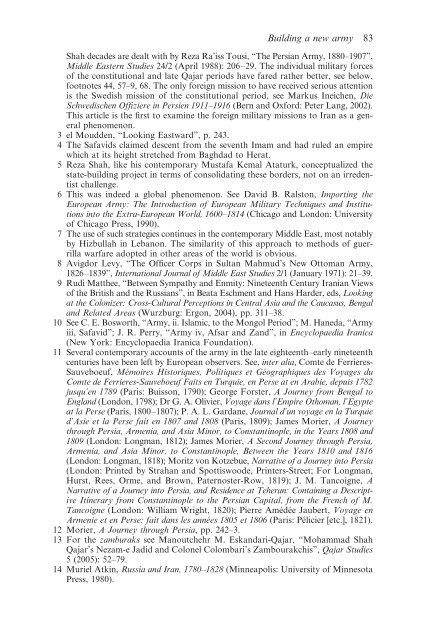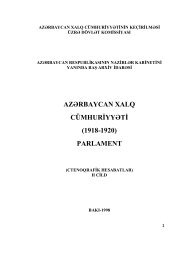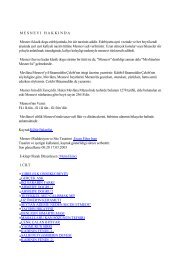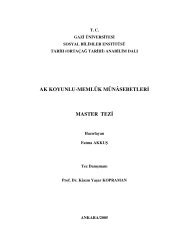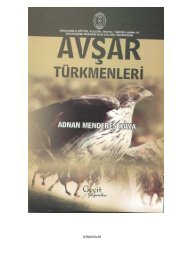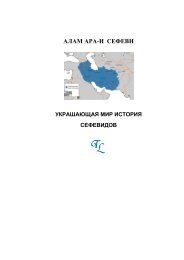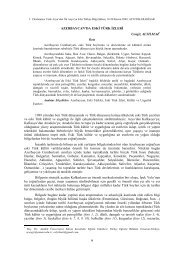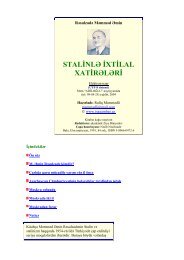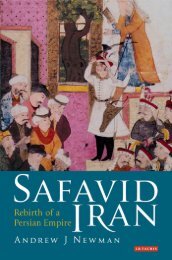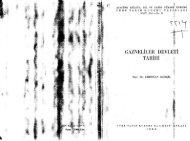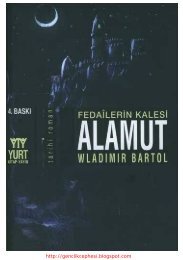Build<strong>in</strong>g a new army 83Shah decades are dealt with by Reza Ra’iss Tousi, “The <strong>Persia</strong>n Army, 1880–1907”,Middle Eastern Studies 24/2 (April 1988): 206–29. The <strong>in</strong>dividual military forcesof the constitutional <strong>and</strong> late <strong>Qajar</strong> periods have fared rather better, see below,footnotes 44, 57–9, 68. The only foreign mission to have received serious attentionis the Swedish mission of the constitutional period, see Markus Ineichen, DieSchwedischen Offiziere <strong>in</strong> Persien 1911–1916 (Bern <strong>and</strong> Oxford: Peter Lang, 2002).This article is the first to exam<strong>in</strong>e the foreign military missions to Iran as a generalphenomenon.3 el Moudden, “Look<strong>in</strong>g Eastward”, p. 243.4 The Safavids claimed descent from the seventh Imam <strong>and</strong> had ruled an empirewhich at its height stretched from Baghdad to Herat.5 Reza Shah, like his contemporary Mustafa Kemal Ataturk, conceptualized thestate-build<strong>in</strong>g project <strong>in</strong> terms of consolidat<strong>in</strong>g these borders, not on an irredentistchallenge.6 This was <strong>in</strong>deed a global phenomenon. See David B. Ralston, Import<strong>in</strong>g theEuropean Army: The Introduction of European Military Techniques <strong>and</strong> Institutions<strong>in</strong>to the Extra-European World, 1600–1814 (Chicago <strong>and</strong> London: Universityof Chicago Press, 1990).7 The use of such strategies cont<strong>in</strong>ues <strong>in</strong> the contemporary Middle East, most notablyby Hizbullah <strong>in</strong> Lebanon. The similarity of this approach to methods of guerrillawarfare adopted <strong>in</strong> other areas of the world is obvious.8 Avigdor Levy, “The Officer Corps <strong>in</strong> Sultan Mahmud’s New Ottoman Army,1826–1839”, International Journal of Middle East Studies 2/1 (January 1971): 21–39.9 Rudi Matthee, “Between Sympathy <strong>and</strong> Enmity: N<strong>in</strong>eteenth Century Iranian Viewsof the British <strong>and</strong> the Russians”, <strong>in</strong> Beata Eschment <strong>and</strong> Hans Harder, eds, Look<strong>in</strong>gat the Colonizer: Cross-Cultural Perceptions <strong>in</strong> Central Asia <strong>and</strong> the Caucasus, Bengal<strong>and</strong> Related Areas (Wurzburg: Ergon, 2004), pp. 311–38.10 See C. E. Bosworth, “Army, ii. Islamic, to the Mongol Period”; M. Haneda, “Armyiii, Safavid”; J. R. Perry, “Army iv, Afsar <strong>and</strong> Z<strong>and</strong>”, <strong>in</strong> Encyclopaedia Iranica(New York: Encyclopaedia Iranica Foundation).11 Several contemporary accounts of the army <strong>in</strong> the late eighteenth–early n<strong>in</strong>eteenthcenturies have been left by European observers. See, <strong>in</strong>ter alia, Comte de Ferrieres-Sauveboeuf, Mémoires Historiques, Politiques et Géographiques des Voyages duComte de Ferrieres-Sauveboeuf Faits en Turquie, en Perse at en Arabie, depuis 1782jusqu’en 1789 (Paris: Buisson, 1790); George Forster, A Journey from Bengal toEngl<strong>and</strong> (London, 1798); Dr G. A. Olivier, Voyage dans l’Empire Othoman, l’Egypteat la Perse (Paris, 1800–1807); P. A. L. Gardane, Journal d’un voyage en la Turquied’Asie et la Perse fait en 1807 <strong>and</strong> 1808 (Paris, 1809); James Morier, A Journeythrough <strong>Persia</strong>, Armenia, <strong>and</strong> Asia M<strong>in</strong>or, to Constant<strong>in</strong>ople, <strong>in</strong> the Years 1808 <strong>and</strong>1809 (London: Longman, 1812); James Morier, A Second Journey through <strong>Persia</strong>,Armenia, <strong>and</strong> Asia M<strong>in</strong>or, to Constant<strong>in</strong>ople, Between the Years 1810 <strong>and</strong> 1816(London: Longman, 1818); Moritz von Kotzebue, Narrative of a Journey <strong>in</strong>to <strong>Persia</strong>(London: Pr<strong>in</strong>ted by Strahan <strong>and</strong> Spottiswoode, Pr<strong>in</strong>ters-Street; For Longman,Hurst, Rees, Orme, <strong>and</strong> Brown, Paternoster-Row, 1819); J. M. Tancoigne, ANarrative of a Journey <strong>in</strong>to <strong>Persia</strong>, <strong>and</strong> Residence at Teheran: Conta<strong>in</strong><strong>in</strong>g a DescriptiveIt<strong>in</strong>erary from Constant<strong>in</strong>ople to the <strong>Persia</strong>n Capital, from the French of M.Tancoigne (London: William Wright, 1820); Pierre Amédée Jaubert, Voyage enArmenie et en Perse: fait dans les années 1805 et 1806 (Paris: Pélicier [etc.], 1821).12 Morier, A Journey through <strong>Persia</strong>, pp. 242–3.13 For the zamburaks see Manoutchehr M. Esk<strong>and</strong>ari-<strong>Qajar</strong>, “Mohammad Shah<strong>Qajar</strong>’s Nezam-e Jadid <strong>and</strong> Colonel Colombari’s Zambourakchis”, <strong>Qajar</strong> Studies5 (2005): 52–79.14 Muriel Atk<strong>in</strong>, Russia <strong>and</strong> Iran, 1780–1828 (M<strong>in</strong>neapolis: University of M<strong>in</strong>nesotaPress, 1980).
84 Stephanie Cron<strong>in</strong>15 For a discussion of the respective military strengths <strong>and</strong> weaknesses of Iran<strong>and</strong> Russia see Atk<strong>in</strong>, Russia <strong>and</strong> Iran, pp. 99–122.16 See Em<strong>in</strong>eh Pakravan, Abbas Mirza (Paris, 1973).17 For an overview see J. Calmard, “Les Reformes Militaires sous les <strong>Qajar</strong>s(1795–1925)”, <strong>in</strong> Y. Richard, Entre l’Iran et l’Occident, pp. 17–42.18 See Pakravan, Abbas Mirza, Paris, 1973.19 Morier, A Second Journey through <strong>Persia</strong>, p. 211.20 Ibid.21 In the Ottoman Empire <strong>and</strong> Egypt, the reform effort could only beg<strong>in</strong> <strong>in</strong> earnestafter the destruction of reactionary military castes, the Janissaries <strong>and</strong> theMamluks respectively. In Iran no such action was necessary as no such forcesexisted, an illustration not of its relatively advanced condition, but rather of itsprimitive civil <strong>and</strong> military structures.22 The presence of such a significant number of Russian deserters <strong>in</strong> Tabriz maybe expla<strong>in</strong>ed by the extremely harsh conditions prevail<strong>in</strong>g <strong>in</strong> the Russian armies<strong>in</strong> the Caucasus. See Atk<strong>in</strong>, Russia <strong>and</strong> Iran, pp. 106–7.23 Morier, A Second Journey through <strong>Persia</strong>, pp. 211–12.24 Fath-Ali Shah to Napoleon, letter quoted <strong>in</strong> Atk<strong>in</strong>, Russia <strong>and</strong> Iran, p. 126.25 For the Gardane mission, see A. de Gardane, Journal d’un voyage en la Turquied’Asie et la Perse; Alfred de Gardane, Mission du Generale Gardane en Perse sousle premier empire (Paris, 1865). For Franco-Iranian relations, see Iradj Am<strong>in</strong>i,Napoleon <strong>and</strong> <strong>Persia</strong> (Richmond: Curzon, Surrey, 1999).26 Tancoigne, A Narrative of a Journey <strong>in</strong>to <strong>Persia</strong>. For the regiment of Russian deserterssee Aleks<strong>and</strong>r Kibovskii, “ ‘Bagaderan’ – Russian Deserters <strong>in</strong> the <strong>Persia</strong>n Army,1802–1839”, Tseikhgauz 5 (1996), trans. Mark Conrad (http://home.comcast.net/-markconrad/Persdes2.html).27 Accounts of this mission <strong>and</strong> of the 1833 British mission may be found <strong>in</strong> DennisWright, The English Amongst the <strong>Persia</strong>ns, dur<strong>in</strong>g the <strong>Qajar</strong> Period, 1782–1921(London, He<strong>in</strong>emann, 1977).28 Aleks<strong>and</strong>r Kibovskii <strong>and</strong> Vadim Yegorov, “The <strong>Persia</strong>n Regular Army of the FirstHalf of the N<strong>in</strong>eteenth Century”, Tseikhgauz 5 (1996), pp. 20–25, trans. MarkConrad (http://home.comcast.net/~markconrod/<strong>Persia</strong>.html).29 Kibovskii <strong>and</strong> Yegorov, “The <strong>Persia</strong>n Regular Army”.30 H. C. Rawl<strong>in</strong>son, Engl<strong>and</strong> <strong>and</strong> Russia <strong>in</strong> the East. A series of papers on the Political<strong>and</strong> Geographical Condition of Central Asia, 2nd edn (London: John Murray, 1875),pp. 30–31. See also, for example, John Malcolm, The History of <strong>Persia</strong> (London,1829).31 For a general discussion of conscription <strong>in</strong> the Middle East see Jan Lucassen <strong>and</strong>Erik J. Zürcher, “Introduction: Conscription <strong>and</strong> the Historical Context”, <strong>in</strong>Zürcher, ed., Arm<strong>in</strong>g the State, pp. 1–19.32 Some observations about the difficulties encountered by the British officers of thismission may be found <strong>in</strong> Lt-Col Stuart, Journal of a Residence <strong>in</strong> Northern <strong>Persia</strong><strong>and</strong> the Adjacent Prov<strong>in</strong>ces of Turkey (London, Richard Bentley, 1854).33 Throughout the n<strong>in</strong>eteenth century the shah possessed a number of Europeanofficers of a wide variety of nationalities <strong>in</strong> his service. See, for example,Mansoureh Etlehadieh <strong>and</strong> S. Mir Mohammad Sadigh, eds, with an <strong>in</strong>troductionby Jean Calmard, Zh<strong>in</strong>ral Sam<strong>in</strong>u dar Khidmat-i Iran-i <strong>Qajar</strong> va Jang-i Hirat,1236–1266 (Tehran, 1375); Bo Utas, “Borowsky, Isidore”, Encyclopaedia Iranica;Jaquel<strong>in</strong>e Calmard-Compas, “Ferrier, Joseph Phillipe”, Encyclopaedia Iranica.34 See Count F. E de Sercey, Une Ambassade Extraord<strong>in</strong>aire. La Perse en 1839–1840 (Paris, 1928); J. Pichon, Journal d’une mission militaire en Perse (1839–1840)(Paris, 1900).35 An account of the French mission may be found <strong>in</strong> Eugene Fl<strong>and</strong><strong>in</strong>, Voyage enPerse (Paris, 1851).
- Page 2 and 3:
War and Peace in Qajar PersiaPersia
- Page 4 and 5:
War and Peace inQajar PersiaImplica
- Page 6 and 7:
ContentsList of figuresContributors
- Page 8 and 9:
Figures5.1 Omani enclaves 1305.2 Ar
- Page 10 and 11:
Contributor listMansoureh Ettehadie
- Page 12:
AcknowledgementsThis volume grew ou
- Page 15 and 16:
2 Roxane Farmanfarmaianrepresented
- Page 17 and 18:
4 Roxane Farmanfarmaianchapter in t
- Page 19 and 20:
6 Roxane FarmanfarmaianThus, two si
- Page 21 and 22:
8 Roxane Farmanfarmaiangaining grea
- Page 23 and 24:
10 Roxane Farmanfarmaiantough deals
- Page 25 and 26:
12 Roxane FarmanfarmaianIranian geo
- Page 27 and 28:
14 Peter W. Averyin Shiraz and cont
- Page 29 and 30:
16 Peter W. Averybut the invasion w
- Page 32:
Part IWar
- Page 35 and 36:
22 Manoutchehr M. Eskandari-Qajarth
- Page 37 and 38:
24 Manoutchehr M. Eskandari-Qajarap
- Page 39 and 40:
26 Manoutchehr M. Eskandari-Qajarmi
- Page 41 and 42:
28 Manoutchehr M. Eskandari-Qajarth
- Page 43 and 44:
30 Manoutchehr M. Eskandari-Qajardo
- Page 45 and 46: 32 Manoutchehr M. Eskandari-QajarIn
- Page 47 and 48: 34 Manoutchehr M. Eskandari-Qajarco
- Page 49 and 50: 36 Manoutchehr M. Eskandari-QajarTh
- Page 51 and 52: 38 Manoutchehr M. Eskandari-Qajarth
- Page 53 and 54: 40 Manoutchehr M. Eskandari-Qajarth
- Page 55 and 56: 42 Manoutchehr M. Eskandari-Qajarop
- Page 57 and 58: 44 Manoutchehr M. Eskandari-Qajarbe
- Page 59 and 60: 46 Manoutchehr M. Eskandari-Qajarva
- Page 61 and 62: 48 Stephanie Cronincapacity and res
- Page 63 and 64: 50 Stephanie Croninforces of the es
- Page 65 and 66: 52 Stephanie CroninPART ONE: THE QA
- Page 67 and 68: 54 Stephanie Croninprincipally on h
- Page 69 and 70: 56 Stephanie CroninThe French offic
- Page 71 and 72: 58 Stephanie CroninEuropean alignme
- Page 73 and 74: 60 Stephanie Croninthe authorities
- Page 75 and 76: 62 Stephanie Croninin the revolutio
- Page 77 and 78: 64 Stephanie Croninof power and sta
- Page 79 and 80: 66 Stephanie Croninliving and the m
- Page 81 and 82: 68 Stephanie Croninconsequences for
- Page 83 and 84: 70 Stephanie Croninrevolution was a
- Page 85 and 86: 72 Stephanie CroninNew British miss
- Page 87 and 88: 74 Stephanie CroninBrigade to a Div
- Page 89 and 90: 76 Stephanie Croninwithout the sove
- Page 91 and 92: 78 Stephanie Croninaccounting devic
- Page 93 and 94: 80 Stephanie Croninbut also faced a
- Page 95: 82 Stephanie Cronindetermined on th
- Page 99 and 100: 86 Stephanie Cronin55 The Anglo-Rus
- Page 101 and 102: 3 The Turko-Persian War1821-1823Win
- Page 103 and 104: 90 Graham WilliamsonThe resultant w
- Page 105 and 106: 92 Graham Williamsonprovincial forc
- Page 107 and 108: 94 Graham WilliamsonThe field armyO
- Page 109 and 110: 96 Graham Williamsonnot hold out mu
- Page 111 and 112: 98 Graham Williamsonoften in arrear
- Page 113 and 114: 100 Graham Williamsonthan any desig
- Page 115 and 116: 102 Graham WilliamsonThere were ove
- Page 117 and 118: 104 Graham Williamsonone should not
- Page 119 and 120: Table 3.2 Persian regional armies (
- Page 121 and 122: 108 Graham WilliamsonIranian influe
- Page 123 and 124: 4 Social networks andborder conflic
- Page 125 and 126: 112 Vanessa MartinPersian troops on
- Page 127 and 128: 114 Vanessa Martinof comparatively
- Page 129 and 130: 116 Vanessa MartinTHE ROLE OF SOCIA
- Page 131 and 132: 118 Vanessa MartinThe Shah’s negl
- Page 133 and 134: 120 Vanessa Martinborder or any oth
- Page 135 and 136: 122 Vanessa Martin44 No. 38, 2 June
- Page 138 and 139: 5 The consolidation of Iran’sfron
- Page 140 and 141: Consolidation of Iran’s frontier
- Page 142 and 143: Consolidation of Iran’s frontier
- Page 144 and 145: Consolidation of Iran’s frontier
- Page 146 and 147:
Consolidation of Iran’s frontier
- Page 148 and 149:
Consolidation of Iran’s frontier
- Page 150 and 151:
Figure 5.2 Arab principalities
- Page 152 and 153:
Consolidation of Iran’s frontier
- Page 154 and 155:
Consolidation of Iran’s frontier
- Page 156 and 157:
Consolidation of Iran’s frontier
- Page 158 and 159:
Consolidation of Iran’s frontier
- Page 160 and 161:
Consolidation of Iran’s frontier
- Page 162 and 163:
6 Narrowing the frontierMid-ninetee
- Page 164 and 165:
Narrowing the frontier 151witnessed
- Page 166 and 167:
Figure 6.1 The 1843 borderlands sta
- Page 168 and 169:
Narrowing the frontier 155And the S
- Page 170 and 171:
Figure 6.2 The 1850 Williams line a
- Page 172 and 173:
Narrowing the frontier 159elicited
- Page 174 and 175:
Narrowing the frontier 161travellin
- Page 176 and 177:
Narrowing the frontier 163be found
- Page 178 and 179:
Narrowing the frontier 165A similar
- Page 180 and 181:
Narrowing the frontier 167and accep
- Page 182 and 183:
Narrowing the frontier 169Perhaps t
- Page 184 and 185:
Narrowing the frontier 171By this s
- Page 186 and 187:
Narrowing the frontier 17346 For a
- Page 188 and 189:
Crime, security, and insecurity 175
- Page 190 and 191:
Crime, security, and insecurity 177
- Page 192 and 193:
Crime, security, and insecurity 179
- Page 194 and 195:
Crime, security, and insecurity 181
- Page 196 and 197:
8 Merchants without bordersTrade, t
- Page 198 and 199:
Merchants without frontier 185the m
- Page 200 and 201:
Merchants without frontier 187and d
- Page 202 and 203:
Merchants without frontier 189photo
- Page 204 and 205:
Merchants without frontier 191their
- Page 206 and 207:
Merchants without frontier 193In an
- Page 208 and 209:
Figure 8.1Seated, first from left:
- Page 210 and 211:
Figure 8.3Seated: Hajj Mohammad-Taq
- Page 212 and 213:
Figure 8.5 Taken in Hajj Hasan Jour
- Page 214 and 215:
Merchants without frontier 201Figur
- Page 216 and 217:
Merchants without frontier 203Studi
- Page 218 and 219:
Merchants without frontier 20516 Me
- Page 220 and 221:
Merchants without frontier 207and t
- Page 222 and 223:
Merchants without frontier 209or pu
- Page 224 and 225:
Merchants without frontier 211It ca
- Page 226 and 227:
9 The politics of concessionReasses
- Page 228 and 229:
The politics of concession 215gradu
- Page 230 and 231:
The politics of concession 217Shah,
- Page 232 and 233:
The politics of concession 219assig
- Page 234 and 235:
The politics of concession 221compa
- Page 236 and 237:
The politics of concession 223gross
- Page 238 and 239:
The politics of concession 225the B
- Page 240 and 241:
The politics of concession 227as th
- Page 242 and 243:
IndexAbbas Mirza, Crown Prince 6, 1
- Page 244 and 245:
Index 231Gulf Arabs 127-9Gwadar 136
- Page 246 and 247:
Index 233policy in Persian Gulf 131


